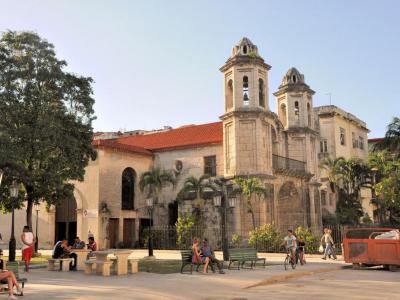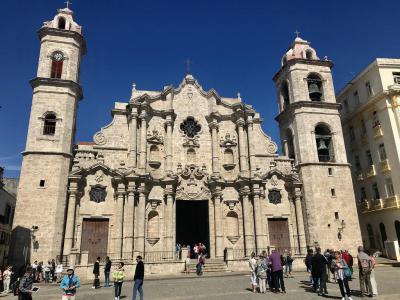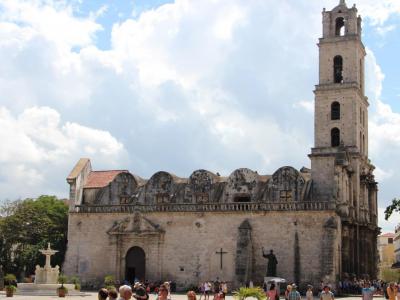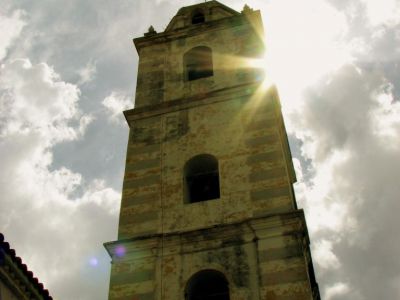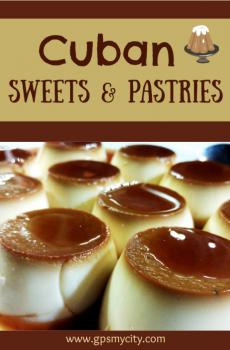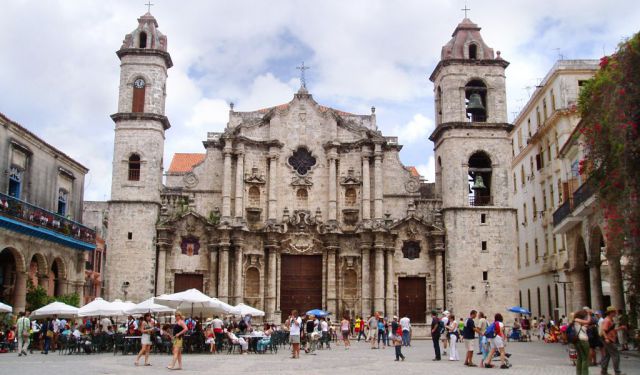
Historical Churches and Cathedrals Walking Tour (Self Guided), Havana
Discovered and conquered by Spanish colonists in the early 16th century, Havana has turned into a major religious center of Catholicism in the Caribbean. Although a communist regime is currently in power, many of the churches, cathedrals, and other religious buildings have been preserved and still give a glimpse of the city’s religious heritage.
The old Havana Cathedral, located in a beautiful square of the Old Town, is among the most important symbols for its architectural style and for having been named the Cathedral of Peace. One of the oldest cathedrals in America, its construction began in 1748 by the Jesuits and was completed 29 years later by the Franciscans. Inside, you may see a splendid altar made in Rome, along with many gilded sculptures, or climb the tower for a small fee and have a view over town.
Furthermore, on a corner of the Plaza de Armas, you may visit El Templete ("Little Temple") – a charming copy of a Doric temple, and the nearby Minor Basilica of Saint Francis of Assisi, completed in 1730 in baroque style with a 40-meter bell tower, which once served as Havana’s main church. Ending the trip is Havana’s oldest Christian site, dating from the 1630s, when it was a hermitage for the devotions of free blacks.
For gorgeous architecture and amazing religious history, this self-guided tour is a definite must!
The old Havana Cathedral, located in a beautiful square of the Old Town, is among the most important symbols for its architectural style and for having been named the Cathedral of Peace. One of the oldest cathedrals in America, its construction began in 1748 by the Jesuits and was completed 29 years later by the Franciscans. Inside, you may see a splendid altar made in Rome, along with many gilded sculptures, or climb the tower for a small fee and have a view over town.
Furthermore, on a corner of the Plaza de Armas, you may visit El Templete ("Little Temple") – a charming copy of a Doric temple, and the nearby Minor Basilica of Saint Francis of Assisi, completed in 1730 in baroque style with a 40-meter bell tower, which once served as Havana’s main church. Ending the trip is Havana’s oldest Christian site, dating from the 1630s, when it was a hermitage for the devotions of free blacks.
For gorgeous architecture and amazing religious history, this self-guided tour is a definite must!
How it works: Download the app "GPSmyCity: Walks in 1K+ Cities" from Apple App Store or Google Play Store to your mobile phone or tablet. The app turns your mobile device into a personal tour guide and its built-in GPS navigation functions guide you from one tour stop to next. The app works offline, so no data plan is needed when traveling abroad.
Historical Churches and Cathedrals Walking Tour Map
Guide Name: Historical Churches and Cathedrals Walking Tour
Guide Location: Cuba » Havana (See other walking tours in Havana)
Guide Type: Self-guided Walking Tour (Sightseeing)
# of Attractions: 6
Tour Duration: 2 Hour(s)
Travel Distance: 3.1 Km or 1.9 Miles
Author: kane
Sight(s) Featured in This Guide:
Guide Location: Cuba » Havana (See other walking tours in Havana)
Guide Type: Self-guided Walking Tour (Sightseeing)
# of Attractions: 6
Tour Duration: 2 Hour(s)
Travel Distance: 3.1 Km or 1.9 Miles
Author: kane
Sight(s) Featured in This Guide:
- Iglesia del Santo Cristo del Buen Viaje (Church of the Good Voyage)
- Havana Cathedral
- El Templete (Little Temple)
- Basílica Menor de San Francisco de Asís (Minor Basilica of Saint Francis of Assisi)
- Iglesia de San Francisco de Paula (Saint Francis of Paula Church)
- Iglesia del Espíritu Santo (Church of the Holy Spirit)
1) Iglesia del Santo Cristo del Buen Viaje (Church of the Good Voyage)
The Church of the Good Voyage (Iglesia del Santo Cristo del Buen Viaje) was built in the mid-17th century and officially designated as a parish church in 1693 by Bishop Avelino de Compostela, one of the leading priests in Cuba at the time.
Constructed during a period when sea voyages were perilous, it gained popularity in the colonial era as a sanctuary for travelers and seafarers. It served as a place of prayer for those embarking on journeys and as a site for expressing gratitude upon returning safely to land. Inside the church, there is an image of Christ on the Cross, believed to offer protection to travelers. In later years, during Cuba's republican period, devotion to Santa Rita was also observed at the church.
The Church of the Good Voyage is known for its simple yet symmetrical design, featuring a baroque façade and two hexagonal towers: the Epistle Tower and the Gospel Tower. The latter houses four bells, with the oldest dating back to 1515. An arch flares outward over the entrance, while inside, the nave boasts a Hispano-Moorish Mudéjar wooden ceiling and a centuries-old crucifix.
As part of the Stations of the Cross tradition, the Iglesia Santo Cristo del Buen Viaje marked the final station of a procession originating from the old Saint Francis church, passing through Calle Amargura. Over the centuries, both the church and its plaza have provided solace and spiritual comfort to penitents seeking respite.
Constructed during a period when sea voyages were perilous, it gained popularity in the colonial era as a sanctuary for travelers and seafarers. It served as a place of prayer for those embarking on journeys and as a site for expressing gratitude upon returning safely to land. Inside the church, there is an image of Christ on the Cross, believed to offer protection to travelers. In later years, during Cuba's republican period, devotion to Santa Rita was also observed at the church.
The Church of the Good Voyage is known for its simple yet symmetrical design, featuring a baroque façade and two hexagonal towers: the Epistle Tower and the Gospel Tower. The latter houses four bells, with the oldest dating back to 1515. An arch flares outward over the entrance, while inside, the nave boasts a Hispano-Moorish Mudéjar wooden ceiling and a centuries-old crucifix.
As part of the Stations of the Cross tradition, the Iglesia Santo Cristo del Buen Viaje marked the final station of a procession originating from the old Saint Francis church, passing through Calle Amargura. Over the centuries, both the church and its plaza have provided solace and spiritual comfort to penitents seeking respite.
2) Havana Cathedral (must see)
Constructed by the Jesuits (1748–77) on the site of an earlier church, Havana Cathedral is one of eleven Catholic cathedrals on the island. It is sometimes dubbed as Christopher Cathedral for being the place where Christopher Columbus’ remains were kept between 1796 and 1898 before they were returned to Spain after the Cuban War of Independence.
The Cathedral is said to be the only example of a baroque facade that was designed with asymmetrical features – one of the towers is wider than the other. This particular feature was conceived in order to allow the water that tended to accumulate on the plaza to freely flow through the streets during the colonial period when it was built.
Cuban writer Alejo Carpentier famously described the Cathedral as "music set in stone". In fact, its structure is notable for being built with stones which are very different from what are used to in Europe. The stones lend the cathedral a particular color and it is really beautiful. Nearby there are terraces, music, and people all around offering drinks, food, cigars, and many more – the essence of the city.
Tip:
Note that despite the official opening times, the Cathedral is often locked, though you can sometimes gain access just before mass. Admission is free, although there is a small charge if you wish to go up the bell tower. Cover-ups for those with short shorts or bare shoulders are available for free
The Cathedral is said to be the only example of a baroque facade that was designed with asymmetrical features – one of the towers is wider than the other. This particular feature was conceived in order to allow the water that tended to accumulate on the plaza to freely flow through the streets during the colonial period when it was built.
Cuban writer Alejo Carpentier famously described the Cathedral as "music set in stone". In fact, its structure is notable for being built with stones which are very different from what are used to in Europe. The stones lend the cathedral a particular color and it is really beautiful. Nearby there are terraces, music, and people all around offering drinks, food, cigars, and many more – the essence of the city.
Tip:
Note that despite the official opening times, the Cathedral is often locked, though you can sometimes gain access just before mass. Admission is free, although there is a small charge if you wish to go up the bell tower. Cover-ups for those with short shorts or bare shoulders are available for free
3) El Templete (Little Temple)
El Templete was built in 1827 to commemorate the site of the first mass celebrated in Cuba on November 16th, 1519. Its architecture represents both the more traditional 19th century Cuban baroque and a more modern Neoclassical style. Pineapples adorn the pillars on the railings and add a tropical flair.
The first mass and town council was held under the shade of a ceiba tree. Every year, on November 16th, a procession is formed to commemorate the city's founding. 16th-century ceremonial maces, usually on display in Museo de la Ciudad (Museum of the City of Havana), lead the procession around Plaza de Armas to the ceiba tree. Havana residents line up all evening to walk around the ceiba tree three times. This ritual is supposed to grant the wish of the supplicant. The original tree had deteriorated over time and was replaced with a younger ceiba tree.
Inside El Templete, visitors will find three large oil paintings by Jean-Baptiste Vermay portraying the original town meeting, first mass, and the temple's inauguration. There's also a bust of Jean-Baptiste Vermay, along with an urn containing the artist's ashes.
The first mass and town council was held under the shade of a ceiba tree. Every year, on November 16th, a procession is formed to commemorate the city's founding. 16th-century ceremonial maces, usually on display in Museo de la Ciudad (Museum of the City of Havana), lead the procession around Plaza de Armas to the ceiba tree. Havana residents line up all evening to walk around the ceiba tree three times. This ritual is supposed to grant the wish of the supplicant. The original tree had deteriorated over time and was replaced with a younger ceiba tree.
Inside El Templete, visitors will find three large oil paintings by Jean-Baptiste Vermay portraying the original town meeting, first mass, and the temple's inauguration. There's also a bust of Jean-Baptiste Vermay, along with an urn containing the artist's ashes.
4) Basílica Menor de San Francisco de Asís (Minor Basilica of Saint Francis of Assisi)
The Minor Basilica of Saint Francis of Assisi, located in the Old Havana district, is a Franciscan convent with a rich history. Construction commenced in 1548 and concluded in 1591, with inauguration occurring in 1575. However, it faced damages from storms in 1680 and 1692, and a hurricane toppled its tower in 1694. Reconstruction efforts began in 1716, continuing over two centuries with structural reforms between 1731 and 1738.
During English rule in Havana, the basilica served as a place of worship before being repurposed for concerts. Adjacent to it stands a 138-foot bell tower, originally graced by a statue of Saint Francis of Assisi, though destroyed in a cyclone in 1846. Today, a statue of Fray Junípero Serra with a Juaneño Indian boy occupies the space.
Architecturally, the basilica blends elements of Corinthian and Doric styles, with traces of early Baroque. Its façade on Trades Street (Calle Oficios) features three stone statues representing the Immaculate Conception, Francis of Assisi, and Saint Dominic. Recognized as a Minor Basilica in 1739, it stands beside the Plaza de San Francisco de Asís, inaugurated in 1628. Alongside Old Havana, it holds UNESCO World Heritage status since 1982.
The monastery's cloister, dating back to 1739, now houses a museum of sacred art. Additionally, a bronze life-size statue by Jose Villa Soberon, depicting José María López Lledín, known as El Caballero de Paris (1899–1985), stands on the basilica's sidewalk, with his burial inside the edifice.
During English rule in Havana, the basilica served as a place of worship before being repurposed for concerts. Adjacent to it stands a 138-foot bell tower, originally graced by a statue of Saint Francis of Assisi, though destroyed in a cyclone in 1846. Today, a statue of Fray Junípero Serra with a Juaneño Indian boy occupies the space.
Architecturally, the basilica blends elements of Corinthian and Doric styles, with traces of early Baroque. Its façade on Trades Street (Calle Oficios) features three stone statues representing the Immaculate Conception, Francis of Assisi, and Saint Dominic. Recognized as a Minor Basilica in 1739, it stands beside the Plaza de San Francisco de Asís, inaugurated in 1628. Alongside Old Havana, it holds UNESCO World Heritage status since 1982.
The monastery's cloister, dating back to 1739, now houses a museum of sacred art. Additionally, a bronze life-size statue by Jose Villa Soberon, depicting José María López Lledín, known as El Caballero de Paris (1899–1985), stands on the basilica's sidewalk, with his burial inside the edifice.
5) Iglesia de San Francisco de Paula (Saint Francis of Paula Church)
Towards the end of the 17th century, the first stone of what would be the hospital for women and the church of San Francisco de Paula was placed. The Presbyter of the Cathedral of Havana, don Nicolás Estévez Borges, in 1664 ordered the construction of a Hospital for Women and an adjoining church devoted to Saint Francis of Paola who was one of the founders of the Roman Catholic Order of the Minims. San Francisco de Paula (1416-1507) was a hermit, famous for his humility and his miracles. His party is celebrated on April 2.
Both buildings were completely destroyed by a hurricane in 1730 and were rebuilt and enlarged in 1745 in the Baroque style we see today, resulting in the Royal Hospital of Havana and the Church of San Francisco de Paula.
In 1907, the Havana Central Railroad, a U. S. company, attempted to acquire the temple for its own corporate use and eventually demolish it, but such efforts were frustrated by the opposition of local historians and anthropologists. Their efforts not only stopped the demolition of the church but also got it listed as National Monument in 1944. Havana Central Railroads, however, was able to bring down the hospital upon approval from the relevant authorities at the time.
An example of the pre-Churrigueresque Baroque style of the first half of the 18th century, the floor plan of the Iglesia de San Francisco de Paula is typologically similar to the Iglesia de San Francisco de Asís as both ground plans are based on a Latin cross. The façade has a central arched doorway and columns at the sides, typical of Spanish churches.
The portion of the church that still exists, the octagonal base of the dome, the façade, and the stained glass windows, all part of the original building of 1745, have all been restored.
As an altarpiece, the church has a stained-glass window. It also has the only organ that has been preserved in Cuba with its original pipe and machinery in its original location. Notably, the church contains the ashes of the Cuban violinist Claudio Brindis de Salas Garrido (1852-1911), considered one of the best violinists of his time.
Both buildings were completely destroyed by a hurricane in 1730 and were rebuilt and enlarged in 1745 in the Baroque style we see today, resulting in the Royal Hospital of Havana and the Church of San Francisco de Paula.
In 1907, the Havana Central Railroad, a U. S. company, attempted to acquire the temple for its own corporate use and eventually demolish it, but such efforts were frustrated by the opposition of local historians and anthropologists. Their efforts not only stopped the demolition of the church but also got it listed as National Monument in 1944. Havana Central Railroads, however, was able to bring down the hospital upon approval from the relevant authorities at the time.
An example of the pre-Churrigueresque Baroque style of the first half of the 18th century, the floor plan of the Iglesia de San Francisco de Paula is typologically similar to the Iglesia de San Francisco de Asís as both ground plans are based on a Latin cross. The façade has a central arched doorway and columns at the sides, typical of Spanish churches.
The portion of the church that still exists, the octagonal base of the dome, the façade, and the stained glass windows, all part of the original building of 1745, have all been restored.
As an altarpiece, the church has a stained-glass window. It also has the only organ that has been preserved in Cuba with its original pipe and machinery in its original location. Notably, the church contains the ashes of the Cuban violinist Claudio Brindis de Salas Garrido (1852-1911), considered one of the best violinists of his time.
6) Iglesia del Espíritu Santo (Church of the Holy Spirit)
Built in 1635 by a fraternity of Afro-Cuban ex-slaves, the Iglesia del Espíritu Santo is Havana's earliest Christian church, and also the only church in Havana to give political asylum. It is also well-known for its possession of some exceptional images on linen, plus a crypt with catacombs. The bell tower on the left side is among the tallest buildings in the old part of the city, though it is said that the main interest lies essentially in the simplicity of the coral stone construction and the lack of lavish decoration.
Inside there are original paintings by the Cuban painter José Nicolás de la Escalera ("Cuba's first painter") and Aristides Fernandez (20th Century), among them the large oil painting titled The Burial of Christ.
The church was rebuilt and expanded in 1648 and given the rank of a parish. During the colonial era it had exceptional importance, since by a Papal Bull of 1772 and a Royal Certificate of 1773, of Charles III of Spain, it was declared "Única Iglesia inmune en esta ciudad, construida en 1855." (”the only immune church in this city, built-in 1855."), which meant that any persecuted individual could find Amparo (sanctuary) in it against the action of the authorities or of justice. A metal plaque at the foot of the bell tower attests to this fact.
Other elements of great importance are the funerary crypts that were discovered in 1953. The crypt is from times before the Colon Cemetery (1876) in El Vedado was built. The crypt is entered from the left of the altar and contains several catacombs.
Many illustrious people of Havana were baptized in this church, among them the educator José de la Luz y Caballero. Bishop Gerónimo Valdés, a founder of La Casa de Beneficencia y Maternidad de La Habana, was buried in the Church; the master sepulcher of Bishop Valdés was found in 1936.
Inside there are original paintings by the Cuban painter José Nicolás de la Escalera ("Cuba's first painter") and Aristides Fernandez (20th Century), among them the large oil painting titled The Burial of Christ.
The church was rebuilt and expanded in 1648 and given the rank of a parish. During the colonial era it had exceptional importance, since by a Papal Bull of 1772 and a Royal Certificate of 1773, of Charles III of Spain, it was declared "Única Iglesia inmune en esta ciudad, construida en 1855." (”the only immune church in this city, built-in 1855."), which meant that any persecuted individual could find Amparo (sanctuary) in it against the action of the authorities or of justice. A metal plaque at the foot of the bell tower attests to this fact.
Other elements of great importance are the funerary crypts that were discovered in 1953. The crypt is from times before the Colon Cemetery (1876) in El Vedado was built. The crypt is entered from the left of the altar and contains several catacombs.
Many illustrious people of Havana were baptized in this church, among them the educator José de la Luz y Caballero. Bishop Gerónimo Valdés, a founder of La Casa de Beneficencia y Maternidad de La Habana, was buried in the Church; the master sepulcher of Bishop Valdés was found in 1936.
Walking Tours in Havana, Cuba
Create Your Own Walk in Havana
Creating your own self-guided walk in Havana is easy and fun. Choose the city attractions that you want to see and a walk route map will be created just for you. You can even set your hotel as the start point of the walk.
Hemingway's Havana Walking Tour
Ever since Hemingway first visited Cuba in 1928 until his death in 1961, he felt an intense connection with the people and culture of Cuba. Hemingway lived at Hotel Ambos Mundos during the 1930s, and began, wrote, and finished several novels there. Today, you can see some of Hemingway's belongings in Room 511.
Hemingway was a frequent patron at El Floridita, famous for its daiquiris.... view more
Tour Duration: 1 Hour(s)
Travel Distance: 1.1 Km or 0.7 Miles
Hemingway was a frequent patron at El Floridita, famous for its daiquiris.... view more
Tour Duration: 1 Hour(s)
Travel Distance: 1.1 Km or 0.7 Miles
Old Palaces Walking Tour
Havana has been the seat of Cuba’s ruling gentry for centuries. Today, you can walk the streets of Old Havana and explore its palaces to get a glimpse into the city’s royal past. Although these structures now serve Havana’s citizens and visitors, they still catch your eye (and your camera lens!) with their architecture and history.
Start your trip with the ornate Presidential Palace,... view more
Tour Duration: 1 Hour(s)
Travel Distance: 2.1 Km or 1.3 Miles
Start your trip with the ornate Presidential Palace,... view more
Tour Duration: 1 Hour(s)
Travel Distance: 2.1 Km or 1.3 Miles
Old Town Walking Tour
The Spanish founded Havana in 1519. After French pirate Jacques de Sores ransacked the city in 1555, the Castle of the Royal Force was built to protect the city.
Havana became a major stopping point between the newly discovered Americas and ancient Europe. In the 1600s, Havana was a major shipbuilding port.
Old Havana is listed as a UNESCO World Heritage Site. The historic city has five... view more
Tour Duration: 2 Hour(s)
Travel Distance: 2.7 Km or 1.7 Miles
Havana became a major stopping point between the newly discovered Americas and ancient Europe. In the 1600s, Havana was a major shipbuilding port.
Old Havana is listed as a UNESCO World Heritage Site. The historic city has five... view more
Tour Duration: 2 Hour(s)
Travel Distance: 2.7 Km or 1.7 Miles
Useful Travel Guides for Planning Your Trip
18 Uniquely Cuban Things to Buy in Havana
Rum, cigars and revolution have been, perhaps, at least until recently, the three most popular exports from Cuba. Luckily, with the embargo lifted (or soon to be lifted), those traveling to the U.S. might soon be able to pick up some of these (with the exception of revolution, perhaps) on their way...
Cuban Sweets and Pastries
On the tropical island where sugar cane is one of the main commodities along with the rum made of the very same sugar, and where the enormous abundance of tropical fruits make up a great deal of the local diet, it is only natural to expect the richness of dessert cuisine. Pair it with the strong...
The Most Popular Cities
/ view all
